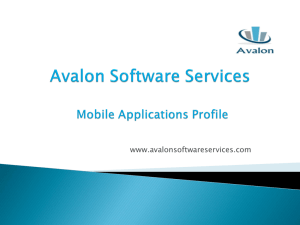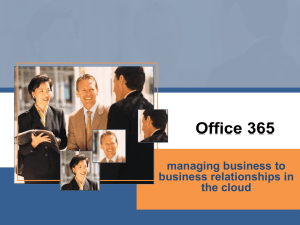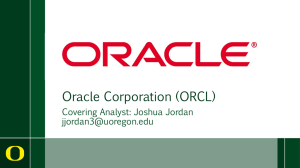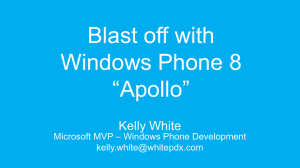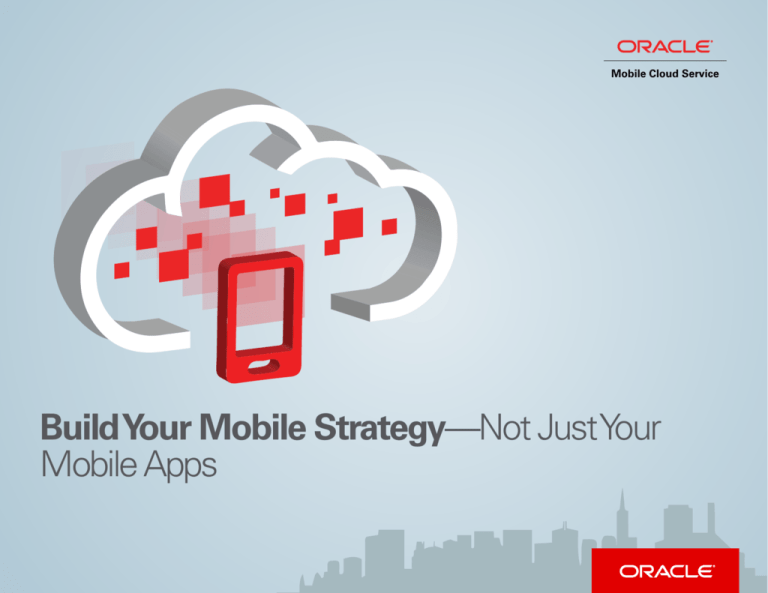
Mobile Cloud Service
BuildYour Mobile Strategy—Not Just Your
Mobile Apps
Whatisisit?
it?
What
Recognize yourself?
Access common
services.
Free up your mobile app
devs.
Empower your service
devs.
Move into the modern
world.
Bring it all together.
Secure your apps.
Keep tabs on your apps.
Get started.
1
What is it?
Oracle Mobile Cloud Service provides everything you need to build out your enterprise mobile strategy
using innovative, state-of-the-art tools. With Oracle Mobile Cloud Service, you have a straightforward way
to:
• Consolidate your app portfolio with API-based
development.
• Manage your reusable assets in a secure,
centralized location.
• Choose a mobile API from the API Catalog or
design your own with clean RESTful design
patterns. Then map it to your back-end
enterprise data, or implement your own logic.
• Monitor performance.
• Cleanly separate API design and
implementation to help keep app updates
backward-compatible.
• Develop fresh and modern B2E and B2C
mobile apps, no matter where the data
resides, using your favorite IDE.
• Secure your apps end-to-end with enterpriseready security patterns.
• Understand if your mobile strategy is
successful with rich mobile analytics.
• Scale as your business grows.
Perhaps most important, Oracle Mobile Cloud
Service provides you with the tools you need to
develop a strategy for supporting your mobile
development. You get the out-of-the-box services
that every mobile app requires, plus the ability
to define and implement new enterprise-ready
APIs quickly and cleanly. What’s more, all API
calls from your Android, iOS, Windows/C#,
or JavaScript client applications are made via
uniform REST calls, thus creating a cohesive
development environment that’s easy to control
and maintain.
Recognize yourself?
How many of these can your enterprise Enter Oracle Mobile Cloud Service
answer “Yes” to?
• A platform that understands the challenges
What is it?
Recognize
Recognizeyourself?
yourself?
Access common
services.
Free up your mobile app
devs.
Empower your service
devs.
Move into the modern
world.
Bring it all together.
Secure your apps.
Keep tabs on your apps.
Get started.
2
• Does your enterprise have experience
with mobile apps—maybe tactical
solutions for providing mobile access to
your data—but find itself lacking a wellcrafted, holistic mobile strategy?
• Are your teams trying to deliver on an
executive order that mandates creating
mobile apps, but the goals are not well
articulated, the development model is
not well defined, and, as a result, the
communication among team members is
poor and disjointed?
• Do you have a mishmash of development
approaches? That is, legacy system data
that you want to expose through mobile
apps (an “inside out” approach) and/or a
vague idea of the mobile apps that you
need to create but no easy way to access
the needed data (more of an “outside in”
situation)?
• Are you being asked to mash up
services from disparate sources, such as
social media, enterprise data, location
information, and more?
of moving enterprise data to mobile in a
secure, scalable, elegant fashion, one that
makes it easy to do things right.
• A set of APIs and declarative tools that can
help you move away from the tactical, and
unite all lines of business along a welldefined strategy, to get enterprise data out
of the back end and into a set of robust and
appealing B2C or B2E mobile applications—
while at the same time addressing each
team member’s top-of-mind concerns.
• A platform that enables development
models driven by mobile app developers
(“outside in”) and by service developers
(“inside out”) simultaneously.
Access common services.
What is it?
Recognize yourself?
Access
Accesscommon
common
services.
services.
Free up your mobile app
devs.
Empower your service
devs.
Move into the modern
world.
Bring it all together.
Secure your apps.
Keep tabs on your apps.
Get started.
3
As the mobile market has matured, it’s become clear that many activities need to be pushed
to the server for maximum efficiency—you simply can’t solve all problems in the client code.
Instead, you need mobile-specific services that accelerate development and make it easy to create
compelling mobile apps. Oracle Mobile Cloud Service provides these services, each of which
expose APIs that mobile app developers can call directly from their client apps, using REST calls or
the client SDKs.
Storage
User Management
Stores data in a collection that can be
accessed by any mobile app. Gets the
data off the client and onto the server
where it belongs.
Simplifies self-registration and login procedures for the mobile app
developer.
Push Notifications
Data Offline and Sync
Adds immediacy to your mobile
apps by communicating with your
users when a significant event
occurs.
Develop apps that can work offline—
even if a mobile user alters content—
then automatically sync up with Oracle
Mobile Cloud Service when they’re
back online.
Free up your mobile app devs.
What is it?
Recognize yourself?
Problem: Enterprise mobile apps are all about presenting an easy-to-use way to interact with data.
Mobile app developers may be bursting with creative ideas for designing elegant user interfaces,
but may find it difficult—or next to impossible—to lay their hands on the data they need. Often
the data is distributed across several back-end systems from on-premises packaged applications,
cloud data, or custom applications that the mobile app developer doesn’t know—or want to
know—how to access. All he wants is a small subset of literally thousands of pieces of data.
What’s the quickest way to get it?
Access common
services.
Free up your mobile app
devs.
Empower your service
devs.
Move into the modern
world.
Bring it all together.
Secure your apps.
Keep tabs on your apps.
Get started.
4
Solution: With the Mobile Cloud Service API Designer, your mobile app developer can sketch out just
the basics of what he needs: resources and methods. Or he can just upload a RAML document—a
simple way of describing RESTful APIs—and call it a day. Either way, he turns over this mini-spec to a
service developer, who understands how the data is structured and formatted.
No need to waste time, however. While the service developer implements the API, the mobile app
developer can continue building his app by leveraging the mock implementation of the API, which
the Mobile Cloud Service generates based on sample data.
When the service developer is finished, the mobile app developer gets a set of clean APIs he can use
to create sophisticated mashups, without ever having to worry about the underlying data structure.
In other words, each type of developer gets to focus on what he does best.
Empower your service devs.
What is it?
Recognize yourself?
Access common
services.
Free up your mobile app
devs.
Empoweryour
yourservice
service
Empower
devs.
devs.
Move into the modern
world.
Bring it all together.
Secure your apps.
Keep tabs on your apps.
Get started.
5
You likely have years’ worth of data scattered throughout your enterprise and stored in onpremises packaged applications, cloud data, or custom applications. And given the explosion of
mobile adoption over the past several years, chances are that you need to provide access to that
data to empower your customers on the move.
Who knows that data best? Your service
developers, of course. With Oracle Mobile
Cloud Service, service developers have a
powerful API Designer to help them build out
those APIs and zero in on the needed data,
so the mobile app developer can take it from
there.
After the API is defined, the service developer
can download a package containing a
JavaScript scaffold to simplify implementation.
Our SDK for JavaScript custom code allows
the developers to call platform services—like
storage, push notifications, offline sync, and
security features—directly from custom code.
And why bother interacting directly with
Apple Push Notifications Service, Google
Cloud Messaging Service, or Windows Push
Notification Service when it’s so much easier
to use Oracle Mobile Cloud Service to send
push notifications? After the service developer
sets up and registers, sending notifications
is identical for both platforms using our
standardized APIs.
To make it easy to get to the data that service
developers need, Oracle Mobile Cloud Service
enables them to declaratively create connector
APIs to interact with on-premises and external
web services. Configured connector APIs are
available in the API Catalog, and can be easily
called from custom APIs—using industrystandard protocols to declare the necessary
service policies.
Mobile Cloud Service also allows service
developers to take advantage of those APIs to
shape data in a way that’s usable by the mobile
app developer. For example, a given web
service may return hundreds of XML fields that
make no sense to put on a mobile device. So,
when creating the connector API, the service
developer can crunch it down to just what the
mobile app developer really needs.
Move into the modern world.
What is it?
Recognize yourself?
Access common
services.
Free up your mobile app
devs.
Empower your service
devs.
Move
Moveinto
intothe
themodern
modern
world.
world.
Bring it all together.
Secure your apps.
Keep tabs on your apps.
Get started.
6
Oracle Mobile Cloud Service gives the
service developer access to modern
technologies. In the mobile world, it’s all
about JavaScript, a simple and ubiquitous
language that most developers are already
well-acquainted with.
In keeping with the world of mobile, all
Oracle Mobile Cloud Service custom code
implementations are done in
Node.js, the platform for building fast,
scalable applications that are both
lightweight and efficient.
Bring it all together.
What is it?
Recognize yourself?
Access common
services.
Unique to Oracle Mobile Cloud Service is the construct
of a mobile backend, which serves as a container for the
set of APIs and other resources needed for a given group
of applications. You can set up multiple mobile backends
to serve different sets of applications, with each backend
containing just the APIs that it needs. Best of all, the entire
mobile backend is deployed as a single entity, which
makes it easy to manage throughout its lifecycle: from
development to staging to production.
Free up your mobile app
devs.
With the Oracle Mobile Cloud Service tools for tracking
dependencies, your architect has answers to such
questions as:
Empower your service
devs.
• Which assets are shared among mobile backends?
Move into the modern
world.
Bring
Bringititall
alltogether.
together.
Secure your apps.
Keep tabs on your apps.
Get started.
7
• Will a change to this asset have a negative impact on
another application?
And with all the complexities of mobile app development
hidden in the backend, the mobile app developer is free to
concentrate on innovating killer apps.
Secure your apps.
What is it?
Recognize yourself?
Access common
services.
Free up your mobile app
devs.
Empower your service
devs.
Move into the modern
world.
Bring it all together.
Secure
Secureyour
yourapps.
apps.
Keep tabs on your apps.
Get started.
8
In Oracle Mobile Cloud Service, enterprise-grade, end-to-end security is built right in. Oracle
Mobile Cloud Service uses the OAuth and Basic Auth security mechanisms for authentication. It all
starts at the mobile backend, where users and client applications authenticate with their security
credentials. From there, you can use mobile user management APIs to define user realms and
roles, and then configure role-based access to API endpoints within the backend (for example, you
can decide which roles are allowed to GET or POST).
When you use connector APIs to take
advantage of outside services, Oracle Mobile
Cloud Service helps you mediate between the
differing security approaches that you may
encounter.
To simplify the propagation of credentials from
client applications when they call Oracle Mobile
Cloud Service platform services, you can use the
client SDKs for the Android, iOS, JavaScript, and
Windows platforms.
For example, say a service you’re connecting
to needs to use SAML authorization and
authentication. After you configure the
appropriate policies, Oracle Mobile Cloud
Service takes care of identity propagation by
transforming the incoming security token into
a SAML token that the service can use.
No one understands enterprise security better
than Oracle. Oracle Mobile Cloud Service is
based on Oracle’s proven integration software
and middleware platform, all running on top
of Oracle WebLogic Server. You don’t have to
worry about scalability, reliability, or security—all
of which are essential to help you construct a
sustainable mobile program.
Keep tabs on your apps.
What is it?
Most mobile initiatives start with a business imperative, like “our sales reps need to
access our CRM system remotely” or “our customers need to log an incident report and
track its resolution on their mobile devices.” After the app is created, how do you know it’s
delivering the results you expected? Are people deleting the app after getting to the third
screen?
Recognize yourself?
Access common
services.
Free up your mobile app
devs.
Empower your service
devs.
Move into the modern
world.
Bring it all together.
Secure your apps.
Keep tabs on your apps.
Get started.
9
Oracle Mobile Cloud Service Analytics
help you gain insight into how (and how
often) customers use applications at any
given time. The data that is gathered
and presented by Oracle Mobile Cloud
Service Analytics enables you to see an
application’s adoption rate, and find out
which functions are utilized the most—or
the least.
With Oracle Mobile Cloud Service Analytics,
you can sort, filter, and drill down into data
from runtime events that are received from
client applications connected to your active
mobile backends.
An event can be the life span of the
application itself or the life cycle of one of
its functions, such as a search or shopping
cart. By automatically applying a context to
this data, which includes both geographic
information and client application details—
like application ID, version, and operating
system—Oracle Mobile Cloud Service
Analytics enables you to home in on trends
and patterns and tune your applications
accordingly.
Oracle Mobile Cloud Service also provides
an SDK so that you can create custom
events to keep aware of app-specific
trends, such as where your active users are
located or how many of them live in a given
geographical region.
Get started.
What is it?
Recognize yourself?
Access common
services.
Free up your mobile app
devs.
Empower your service
devs.
Move into the modern
world.
Bring it all together.
Secure your apps.
Keep tabs on your apps.
Get
Getstarted.
started.
10
Subscribe
Attend Oracle Cloud Events
For information about subscribing, see
Trial and Paid Subscriptions for Oracle
Cloud Services and visit the Oracle Cloud
website at cloud.oracle.com.
See events.oracle.com and blogs.oracle.com/cloud
for information about Oracle Cloud events.
Join the Community
• Oracle Cloud Community: cloud.oracle.com
• Oracle Cloud Computing Group
Safe Harbor
The preceding is intended to outline our general product direction. It is intended for information purposes
only, and may not be incorporated into any contract. It is not a commitment to deliver any material, code, or
functionality, and should not be relied upon in making purchasing decisions. The development, release, and
timing of any features or functionality described for Oracle’s products remains at the sole discretion of Oracle.
Follow us at:
Oracle Cloud on Facebook
Oracle Cloud on Twitter
Oracle Cloud on YouTube
Oracle Mobile Cloud Website
#oraclemobilecloud
v. Jan 21, 2016
Copyright © 2014. Oracle and/or its affiliates. All rights reserved.
This document is provided for information purposes only, and the contents hereof are subject to change without notice. This document is not warranted to be error-free,
nor subject to any other warranties or conditions, whether expressed orally or implied in law, including implied warranties and conditions of merchantability or fitness for a
particular purpose. We specifically disclaim any liability with respect to this document, and no contractual obligations are formed either directly or indirectly by this document.
This document may not be reproduced or transmitted in any form or by any means, electronic or mechanical, for any purpose, without our prior written permission.
Oracle and Java are registered trademarks of Oracle and/or its affiliates. Other names may be trademarks of their respective owners.
Intel and Intel Xeon are trademarks or registered trademarks of Intel Corporation. All SPARC trademarks are used under license and are trademarks or registered trademarks of
SPARC International, Inc. AMD, Opteron, the AMD logo, and the AMD Opteron logo are trademarks or registered trademarks of Advanced Micro Devices. UNIX is a registered
trademark of The Open Group.



